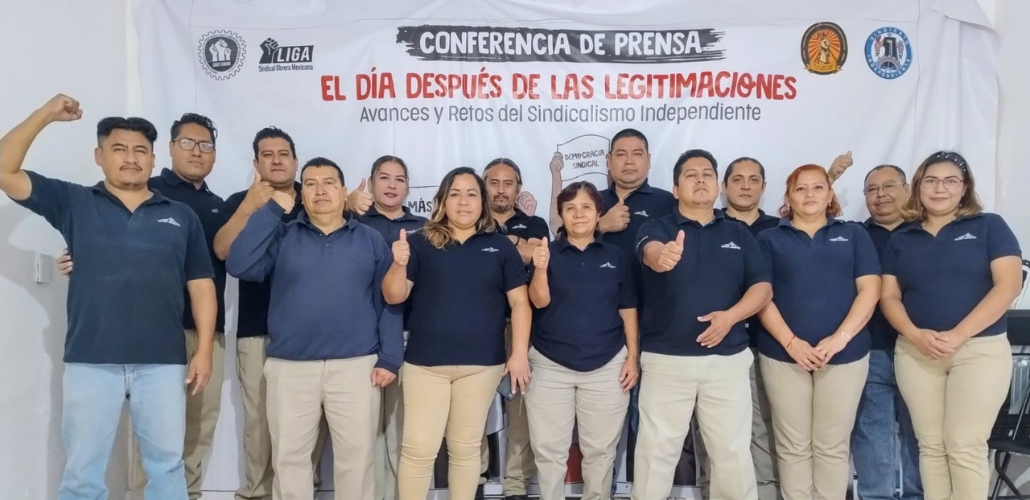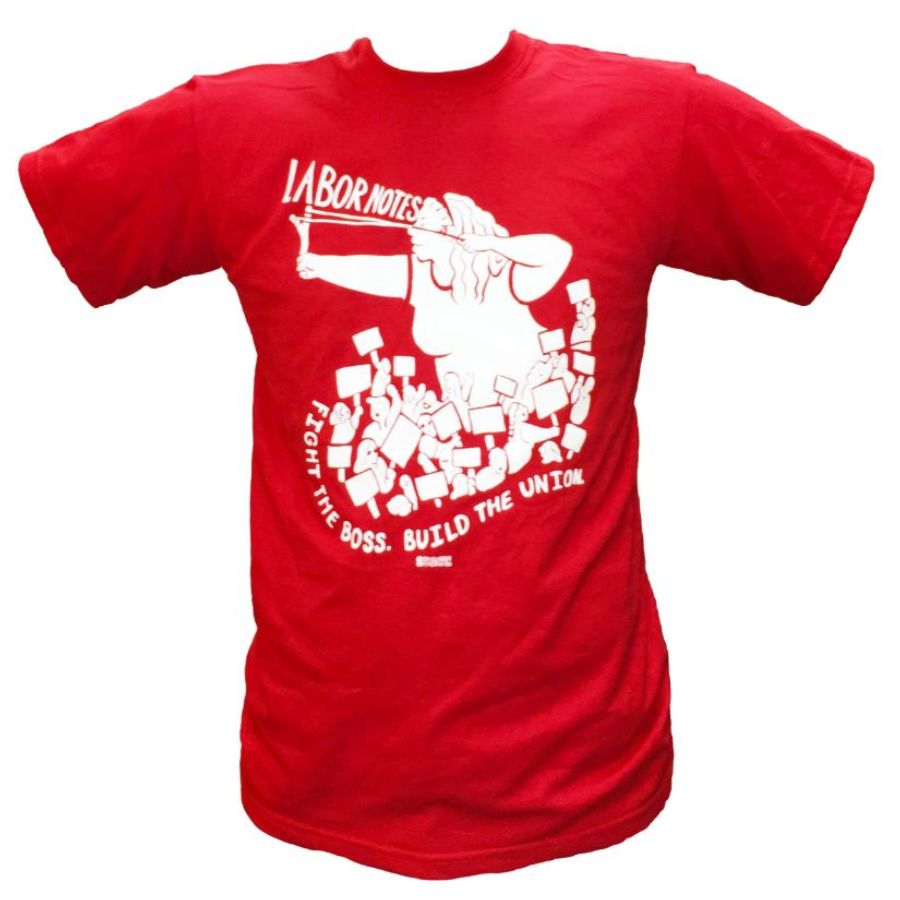What Could Workers Win in a New NAFTA?

Members of the independent union at the Saint Gobain factory in Mexico took part in a press conference about the organizing opportunities that labor law reforms have opened up. Photo: The Independent Union of Free and Democratic Workers of Saint Gobain Mexico
In his nine years in the auto industry, Ben Hinsey has seen a lot of misplaced blame. The threat of job cuts is always looming.
In fact, Hinsey transferred into his current job at the Stellantis Jeep factory in Toledo, Ohio, when his previous one at the Chrysler Toledo Machining Plant evaporated in a 2017 wave of layoffs. He now installs instrument panels and serves as a float, moving from job to job to cover absences.
Hundreds of thousands of auto jobs have disappeared from the U.S. since the North American Free Trade Agreement in 1994 and its successor, the U.S.-Mexico-Canada Agreement (USMCA), often known as NAFTA 2.0. Wages plummeted as bosses threatened to close plants and move work south of the border.
Many U.S. auto workers resent Mexican workers. “A lot of the spin on NAFTA is just like, ‘It screwed the U.S.,’” Hinsey said. “But not really; it screwed over the workers everywhere.”
President Trump recently announced he wants to renegotiate the USMCA now, well ahead of the required review in 2026.
FORCED TO MIGRATE
There’s a widespread misconception that American workers’ loss was Mexican workers’ gain. In reality, the only winners were multinational corporations. Average wages for Mexican auto workers were cut in half between 1994 and 2016.
To show how NAFTA hurt workers everywhere, Hinsey points to the flood of cheap U.S. corn to Mexico. Mexican farmers paid the price—they couldn’t compete with mechanized farms that the U.S. government was subsidizing to the tune of $5 billion per year. Two million people lost their land, land that had often sustained families for generations.
With no better options, millions of Mexican workers went north in search of jobs. Some competed for scarce and low-paying maquiladora jobs and agricultural work along the border; many found their way to the U.S. and low-paid work in the fields or slaughterhouses.
Hinsey feels a kinship with these workers because his family, too, once owned a small farm, and lost it during the Great Depression. “Some of those people found jobs at factories in Toledo,” he said. “That’s the history of why I work in auto plants.”
THE RIGHT TO ORGANIZE
The USMCA continued the NAFTA framework of eliminating most tariffs on products traded between the U.S., Mexico, and Canada.
But it also did something new: it mandated labor law reforms in Mexico that independent union activists had been demanding for decades—establishing labor courts and requiring a secret-ballot vote to legitimate all existing collective bargaining agreements, an effort to rid workers of pro-boss “protection contracts”—though these changes have not yet yielded the surge in unionization that activists had hoped for.
A key provision is the rapid-response mechanism, which allows unions and workers to bring complaints against employers who violate workers’ right to organize in Mexico. Facilities found to be in violation face sanctions and ultimately may lose access to the U.S. market.
In the auto sector, the USMCA requires that 75 percent of a vehicle be made of parts from one of the three countries—up from 62.5 percent under NAFTA—and that 40 to 45 percent be made by workers earning at least $16 per hour.
“The labor chapter has been the strongest of any trade agreement in the world,” said Paul Bocking, with the Humanity Fund of the United Steelworkers (the international solidarity arm of the Canadian USW). “That doesn’t say very much. It’s a very low bar, because trade agreements by their definition are about facilitating rights and powers to capital.”
UNIONS THAT BACK THE BOSS
Although on paper about 13 percent of Mexican workers are unionized, many of them have for decades struggled under “protection contracts,” imposed by employer-friendly “unions” without worker input—and often even without their knowledge.
These pro-employer unions suppress wages and stifle efforts at seeking true representation, eroding the floor for labor standards.
As long as workers in Mexico make only a fraction of U.S. wages, bosses will leverage the threat to drive down standards. “That was part and parcel of the contract givebacks that affected the United Auto Workers for decades,” said Scott Houldieson, an electrician who has worked at Ford Chicago Assembly for 35 years. “We were always being told that we were lucky we have our jobs, and ‘Take this bad contract, the company’s in trouble now.’ But always lurking behind that was the threat of moving product to Mexico.”
“Our members, who get paid roughly $35 an hour, have been asked to somehow figure out how they can compete with workers that make $3 an hour,” said Jason Wade, an assistant to UAW President Shawn Fain. “Those workers should be paid either the exact same or in close proximity to what American workers earn, because they're creating the same value for those companies.
“These companies cannot continue to be allowed to ‘compete’ based on how badly they screw over and pit Mexican and U.S. workers against each other.”
A HIGH-STAKES REVIEW
Under the USMCA’s review clause, the three countries must convene and consider whether to modify, extend, or withdraw from it. The first deadline is July 1, 2026.
President Donald Trump’s second term adds uncertainty. Trump has vowed to impose a 25 percent tariff on Mexico and Canada; this would almost certainly violate the USMCA, which is premised on duty-free trade between the three countries.
Trump has also threatened a 200 percent tariff on John Deere if the company continues to shift production to Mexico—a charge the company denies despite relentless layoffs over the past year, and despite its stated plans to shift the manufacturing of skid steer loaders and compact track loaders from Iowa to Mexico by 2026.
EMPTY THREATS?

SUPPORT LABOR NOTES
BECOME A MONTHLY DONOR
Give $10 a month or more and get our "Fight the Boss, Build the Union" T-shirt.
But many observers believe Trump’s threats are empty. “If Trump puts punitive tariffs on Mexican imports to the United States, it will destroy the supply chains of the U.S. auto industry,” said Jeff Hermanson, former organizing director of the Solidarity Center in Mexico.
“Every U.S. auto manufacturer, including the Big Three and companies like Volkswagen, Tesla, Hyundai, and Kia, depend on components and parts manufactured in Mexico,” Hermanson said.
“Every Dodge Ram Hemi V-8 engine is made in Mexico, for example. Transmissions, axles, brakes, interiors, windshields are imported from Mexico, made by workers earning one-tenth the wages of U.S. auto workers. Tariffs on these goods will either cut off the supply or significantly raise the price of the final product, or both.”
Analysts for Barclays bank say Trump’s tariff plan “could wipe out effectively all profits” from the Big Three automakers.
Mexican President Claudia Sheinbaum signalled that Mexico could reciprocate through tariffs on U.S. goods. Mexico’s Minister of Economy Marcelo Ebrard warned that these tariffs would lead to the loss of 400,000 U.S. jobs, calling the move “a shot in the foot.”
Meanwhile Canadian Prime Minister Justin Trudeau scrambled to meet with Trump after the threats, but returned home without any commitments in place, despite other leaders’ fawning efforts to contrast Canada with Mexico. Weeks later, Trump threatened to annex Canada.
LABOR’S DEMANDS
The review process presents an opportunity to improve on the agreement, if organized labor can coalesce around demands. During the initial USMCA negotiations, labor won significant improvements.
The rapid-response mechanism has allowed thousands of workers to assert their rights and create independent unions, breaking from the tradition of pro-employer unionism. But the mechanism is limited in scope: it functionally applies only to workers in Mexico.
“We’d like to see that expanded out to all of North America,” said Lana Payne, president of Unifor, Canada’s largest private sector union. Suppose her union could work with the Canadian government to file a complaint against, for instance, Mercedes for abusing workers’ rights in Alabama—and if the company didn’t shape up, block it from selling cars in Canada?
Even within Mexico, the mechanism deals only with the rights to free association and collective bargaining—so safety on the job, gender violence, and the treatment of immigrants fall outside its purview.
Also, only certain industries are covered, said Sandra Polaski, a member of the Independent Mexico Labor Expert Board created by Congress as part of the USMCA. She would like it to cover agriculture, a sector where “there are enormous violations of worker rights,” she says, “in both the U.S. and Mexico, and probably in Canada as well.”
And even where a facility is found to be in violation, there’s nothing stopping it from dodging its obligations by packing up shop and leaving the country. That’s what happened at VU Manufacturing, in the border state of Coahuila, where auto parts workers voted to form an independent union.
After two rapid-response petitions established that VU was denying workers’ rights to organize and bargain, the U.S. and Mexico landed on a course of remediation: the company must affirm its neutrality and non-interference in union activities, discipline HR staff, and promptly report any further violations. Instead, the Michigan-based company simply shut down the facility—leaving hundreds of workers blacklisted and without legally mandated severance pay.
GOOD ORGANIZING TERRAIN
Mexican workers have held wildcat strikes and organized in the face of smears and intimidation. They’ve built independent, fighting unions—ousting management-aligned protection unions at General Motors’ Silao plant, a Saint Gobain auto parts facility in Cuautla, Morelos, and Goodyear’s San Luis Potosí facility, and waging a sustained strike at Caterpillar’s Nuevo Laredo facility.
But it’s an uphill climb. The government’s message about new labor rights still hasn’t reached millions. Organizers are up against deeply entrenched wariness; unions have a reputation for colluding with the boss. Workers have faced vote tampering, retaliation, and threats of violence.
Mexico’s independent unions are largely new institutions, and can hire only a handful of organizers. The workers centers that support nascent organizing campaigns have ambitious goals and shoestring budgets.
“Before the labor law reforms, workers didn’t have a voice or a vote,” said Gabriel Mendoza of the independent union at the Saint-Gobain materials plant in Morelos. “A company made arrangements with the union leader, and workers’ input didn’t matter. If they tried to organize, they’d be fired.”
And even now, “workers’ right to free association is often violated,” said Joaquin Guzman, the union’s general secretary. “Workers are fired, and in the worst cases, they and their families are threatened by charro [corrupt] unions.
“Workers still live with fear. To some degree they fear being fired, but much more so they fear the death threats against them and their families. We’d like to see the reform [through USMCA] have greater emphasis on that area.”
A NEW C.I.O.?
To reverse the downward trend of wages across the continent, North American unions will have to offer serious support to organizing in Mexico. Hermanson sees an opportunity like the U.S. in the 1930s, when unionists determined to unionize large numbers of blue-collar workers formed what would become the Congress of Industrial Organizations.
“The CIO hired 100 organizers,” he said. “And as a result, there was a UAW, there were rubber workers, steel workers, electrical workers, farm equipment workers, furniture workers—all of these industries were organized with 100 organizers. Mexico is equally good terrain for that kind of mass organizing campaign.”
“If North America is all gonna be one market, then unions need to be able to coordinate across it,” Hinsey said.






